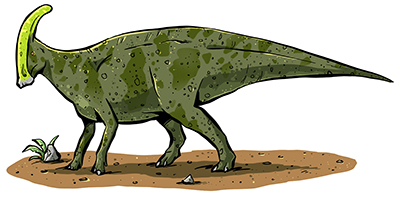Parasaurolophus
Parasaurolophus
- Pronunciation:
- pa-ra-saw-ROL-off-us
- Name meaning:
- 'like 'Saurolophus''


- Type of dinosaur:
- large ornithopod
- Length:
- 9.0m
- Weight:
- 5000kg
- Diet:
- herbivorous
- Teeth:
- beak and toothed jaws
- Food:
- pine needles, tree leaves
- How it moved:
- on 2 or 4 legs
- When it lived:
- Late Cretaceous, 77-73 million years ago
- Found in:
- Canada, USA
Parasaurolophus was a duck-billed dinosaur with a long, distinctive head crest. It lived in what is now North America during the Late Cretaceous Period.
Over the years, experts have gone back and forth as to whether Parasaurolophus walked on two legs or four. We now think it did both. It probably spent most of its life walking on all fours, but it could raise itself onto its back legs.
Fossilised skin impressions show that Parasaurolophus had scaly, pebbled skin.
A dinosaur found in China called Charonosaurus looked very similar. Some scientists think it could be the same animal as Parasaurolophus.
What does Parasaurolophus mean?
Parasaurolophus is partly named after Saurolophus another duck-billed dinosaur. Its name means 'lizard crest'.
The Canadian scientist William Parks, who wrote the first paper about Parasaurolophus, thought it looked very similar, so he gave it a name meaning 'like Saurolophus'.
What did Parasaurolophus use its crest for?
Parasaurolophus is famous for its crest, which was hollow. Starting from the dinosaur's nostrils, an empty tube ran through the crest, looped around at the end and then travelled back to the skull.
Nobody knows for sure what the crest was for. Experts think Parasaurolophus may have used it to spot other members of its species, to communicate with others by blowing air through the crest to create loud sounds, or to control its body temperature. The crest probably had more than one use.
Researchers have found a few different Parasaurolophus skulls. Some of them had smaller, differently shaped crests. Perhaps this was because some were from males and others were from females, or maybe the individuals were different ages.
So far, we know of three species of Parasaurolophus. Each of these also has a different crest shape and size.
What did Parasaurolophus sound like?
In the 1990s, scientists realised they could recreate the sound a Parasaurolophus would make if it blew air through its crest.
The result is a deep, trumpeting bellow that the dinosaur might have used to warn other Parasaurolophus about nearby dangers. You can listen to this computer-generated sound on YouTube.
Of course, nobody knows if Parasaurolophus really sounded like this. But for now, it's as close as we're likely to get to hearing a real dinosaur.
Did Parasaurolophus eat meat?
No, Parasaurolophus lived on a diet of plants. It ate by making a tooth-grinding chewing motion.
Like other members of the hadrosaur group, Parasaurolophus had a complicated arrangement of hundreds of teeth. But it only used a few at a time. Most of the teeth were kept in reserve, ready to replace old ones worn down by grinding plant matter.
What hunted Parasaurolophus?
Parasaurolophus lived alongside many large predators, including Gorgosaurus and Daspletosaurus, two earlier relatives of Tyrannosaurus rex.
Other than being quite large - which made it difficult for an attacker to handle - nobody knows if Parasaurolophus had any special way of defending itself. Scientists think it probably lived in herds and there's safety in numbers.
Taxonomic details
- Taxonomy:
- Dinosauria, Ornithischia, Ornithopoda, Hadrosauridae, Lambeosaurinae
- Named by:
- Parks (1922)
- Type species:
- walkeri

Step back in time
Find out more about dinosaurs' lives and the world they lived in.

Fun and games
Learn more about dinosaurs through toys, board games and activity kits, available from our online shop.

Dinosaurs gallery
Roarrr. Come face-to-face with some of the Museum's most famous dinosaurs.




